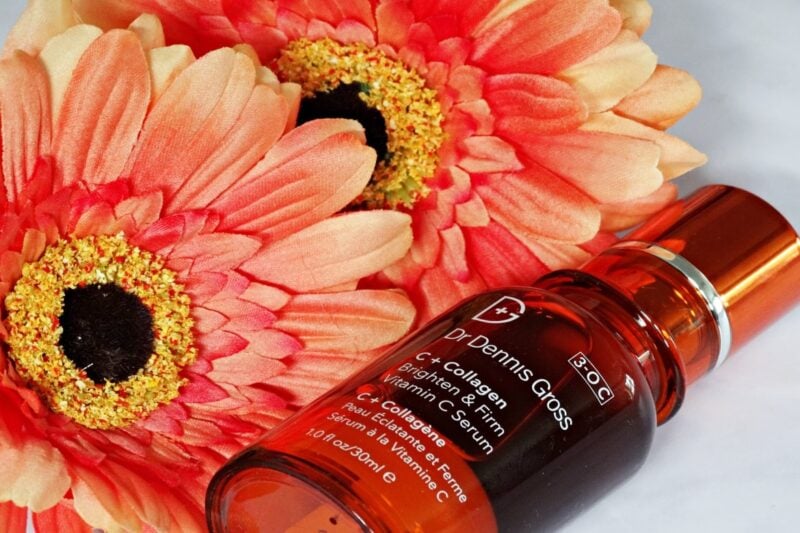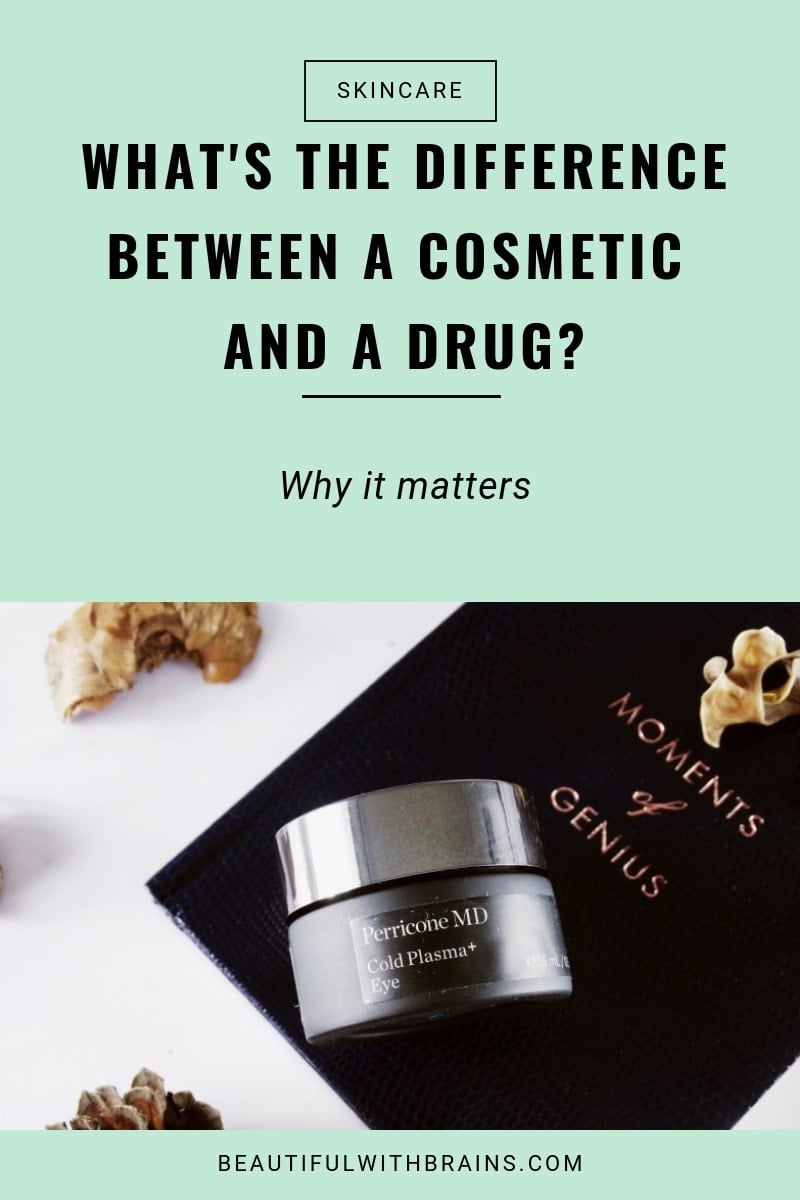Have you ever wondered why some skincare products are considered cosmetics and freely available OTC and others are called drugs and you need a prescription to use them?
What’s the different between a cosmetic and a drug?
It all depends on its intended purpose. Here’s what I mean:
What’s A Cosmetic?
According to the Federal Food, Drug, and Cosmetics Act1, a cosmetic product is anything “itended to be rubbed, poured, sprinkled, or sprayed on, introduced into, or otherwise applied to the human body… for cleansing, beautifying, promoting attractiveness, or altering the appearance.”
A few examples:
- Deodorant
- Eyeshadow
- Lipstick
- Moisturizer
- Shampoo
- Toothpaste
Cosmetics don’t interfere with any bodily function, so they aren’t required to undergo strict tests to determine their efficacy.
Basically, you can sell something that doesn’t work (and we’ve all come across a few) as long as it doesn’t contain anything harmful or dangerous. Contrary to popular opinion, you CAN’T put toxic stuff in cosmetics.
Related: What Really Works To Fight Wrinkles?
Want to get the most out of your skincare products? Click on the image below to subscribe to my newsletter and receive the “How To Combine Actives Like A Pro” cheatsheet.
What’s A Drug?
The same act, FD&C Act defines drugs as anything “intended for use in the diagnosis, cure, mitigation, treatment, or prevention of disease” and “articles (other than food) intended to affect the structure of any function of the body of man or other animals.”
For example, a sunscreen can prevent diseases, which is why it is considered a drug.
Because drugs can affect the body on a much deeper level, they need to undergo very strict tests before they can be sold. These tests need to prove the product is both effective and safe. And, this takes a lot more time and money.
That’s why brands hate to deal with drugs. They’d rather say that something is intended to just beautify skin – even when it affects the body on a deeper layer – and skip the whole drug approval process altogether. Yes, they can – and DO – that.
Can A Skincare Product Be Both A Cosmetic And A Drug?
Of course! Cosmetics and drugs can have babies. They’re called OTC drugs because you get them without a prescription.
OTC drugs are products with two purposes. For example:
- Antidandruff shampoo: Cleanses hair (cosmetic use) and treats dandruff (drug use)
- Moisturizer with SPF: Beautifies skin (cosmetic use) and prevents cancer (drug use)
These hybrids need to comply with the requirements for both drugs and cosmetics. This is probably why so many moisturizers still don’t have SPF…
Related: Do Cosmetics With SPF Provide Adequate Sun Protection?

How Is Intended Use Established?
If you’ve read this far, you think that’s pretty obvious. But, have you noticed the “intended for use” bit in the definition? Those three words make things a lot trickier.
You see, products are not classified one way or another according to their type (ie, lipstick or shampoo), but by its intended use. So, how is that established?
It depends both on the ingredients included and the claims the product makes.
For example, some ingredients, such as fluoride, have a well known therapeutic use, so anything that contains them is automatically considered a drug.
On the other hand, products that contain ingredients that can alter the structure and function of the body, like retinol (it can boost collagen production and accelerate cellular turnover), can be considered cosmetics if they claim to only beautify skin.
In addition, products marketed as cosmetics can be considered drugs when they claim to treat diseases or affect the function of the human body. This is the case for products that claim to reduce cellulite, increase collagen production, and accelerate cellular turnover.
Confused much?
How Can You Tell If A Skincare Product Is A Cosmetic Or A Drug?
Basically, the very same product can be considered either a cosmetic or a drug, depending on how it is marketed.
For this example, let’s take a fragrance.
Does it claim to only make you smell good? Then, it’s a cosmetic.
Does it also claim to help you fall asleep? Then, it’s a drug.
I know, it’s ridiculous. And unnecessarily confusing. But it’s how it currently works. *sighs*

What Happens When A Company Gets It Wrong?
That happened to Lancome.
When the Genefique serum first came out, they said it could “boost the activity of genes” to turn back the clock. Who wouldn’t want that? I mean, if you’re going to spend almost $100 on a serum, you want it to do more than just fill in fine lines and wrinkles with silicones.
But, anything that can interfere in any way with genes is considered a drug. This means Genefique should have undergone much more rigorous testing… and those cost a hell of a lot of money.
Lancome wasn’t willing to pay the price for the tests, but was more than eager to make drug claims to attract customers.
The result? Lancome had to hastily change the marketing spiel or Genefique would have been pulled from the market.
Mind you, though, they didn’t have to change the formula. No one bothered to check if there’s anything in the product that can really affect the way genes behave.
As long as Lancome limits itself to making only cosmetic claims, and uses no ingredient with a well known therapeutic history, it can keep using whatever it is it’s using.
And, if you ask me, that’s fucked up. Because if the product can really “boost the activity of genes” then it needs to be throughoutly tested before it can be sold to prevent any possible unwanted side effects.
And, if it can’t, Lancome should be punished more harshly for lying, don’t you think?
The Bottom Line
Determining whether a product is a cosmetic or a drug can be pretty confusing, can’t it? It all depends on its intended use, not its ingredients. How crazy is that?
What are your thoughts on how skincare products are classified as cosmetics or drugs? Let me know in the comments below.


The cosmetic or drug debate is confusing sometimes. We have vitamin A, which is considered to be a drug and a supplement. But as retinol, it is also an ingredient in cosmetics. Hyaluronic acid is another example. Currently, the FDA does not regulate on cosmetics and supplements. Remember Latisse? It used to be a non-prescription item until the FDA found out the active ingredient is used in a type of eye drop.
Dao, I agree that the whole thing can be really confusing. Unless one of the ingredients used has therapeutical properties, it really depends a lot on how the company markets a product and the claim they make. That’s why products with ingredients such as retinol can be considered both a cosmetic and drugs depending on the promises they make. I think it gets ridiculous sometimes and that there should be clearer rules.
This was a great post! Thanks
Monique, you’re welcome. I’m glad you enjoyed it.
♥ the post!!
Gauri, thanks. I’m glad you do. 🙂